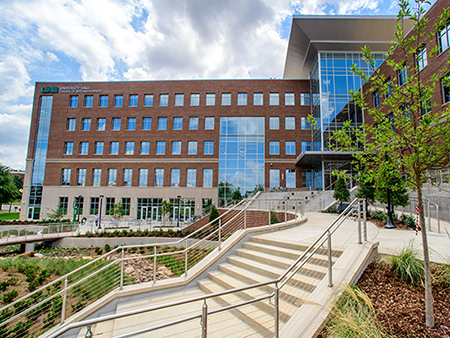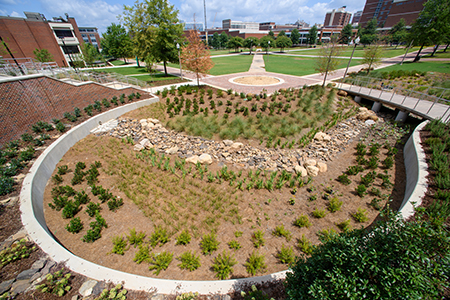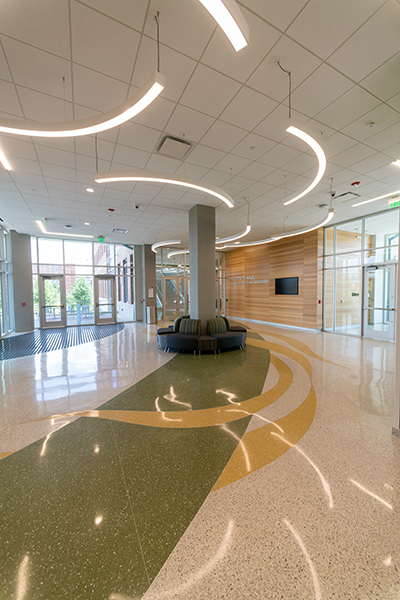 Sun orientation and proximity to interior public spaces were considered to maximize natural daylight while minimizing solar heat gain. University Hall, the University of Alabama at Birmingham’s newest classroom and office space, is set to receive a Leadership in Energy and Environmental Design certification. The new College of Arts and Sciences building will be the first LEED-certified building on UAB’s campus, saving energy, water and resources and generating less waste.
Sun orientation and proximity to interior public spaces were considered to maximize natural daylight while minimizing solar heat gain. University Hall, the University of Alabama at Birmingham’s newest classroom and office space, is set to receive a Leadership in Energy and Environmental Design certification. The new College of Arts and Sciences building will be the first LEED-certified building on UAB’s campus, saving energy, water and resources and generating less waste.
According to the United States Green Building Council, LEED certification is the most widely used green building rating system in the world. It provides a framework to create healthy, highly efficient and cost-saving green buildings.
“This is our first LEED-certified building and shows our commitment to sustainability and the environment,” said Melody Gillezeau, project manager for sustainable project development in the Facilities Division. “We anticipate this will be the first of many sustainable buildings. We have several projects in the planning phases and two current construction projects in the works that are seeking LEED certification.”
The LEED certification of University Hall plays a part in achieving UAB Sustainability’s strategic plan, which includes an overarching aim to design, construct and maintain buildings in ways that provide a safe and healthy indoor environment for users while simultaneously mitigating the building’s impact on the outdoor environment.
Energy Conservation
The state of Alabama has adopted one of the most stringent energy codes in the United States, with only nine other states having equivalent or higher requirements for energy efficiency. University Hall is designed to achieve 9.1 percent additional energy cost savings, compared to a baseline building that solely meets Alabama’s energy code requirements.
“The overall design of the building reduces energy costs by maximizing daylight in collaborative spaces and economizing on the energy used within the building,” Gillezeau said.
The energy cost savings is due to a combination of energy conservation measures, from HVAC efficiency to roof composition and interior lighting, including: The landscape features a bridge that crosses a bioswale — natural solutions to storm water management — integrating sustainability with the user experience.
The landscape features a bridge that crosses a bioswale — natural solutions to storm water management — integrating sustainability with the user experience.
- Glazed components sized and specified based on sun orientation and proximity to interior public spaces. This maximizes natural daylight while minimizing solar heat gain. Gillezeau notes that Birmingham’s climate is within a comfortable range for about 7 percent of the year, otherwise smart building strategies need to be employed to ensure that a thermally comfortable indoor environment for learning, teaching and working is provided.
- University Hall’s energy recovery ventilator lowers the amount of energy needed for summertime cooling and dehumidification and wintertime heat. It does this by recovering heat and moisture from the exhaust airstream and transferring it to the outside air that is required for ventilation.
- Reflective light-colored roofing, a UAB standard for suitable new roofs on campus in order to reduce the urban heat island effect, decreases the cooling requirement for air-conditioned spaces, hence saving energy and improving thermal comfort in non-air-conditioned spaces.
- Energy to cool the outside air is saved by using airside economizers for “free cooling” during mild weather.
- Lighting energy is reduced by using LED lamps, along with occupancy sensors and daylight sensors throughout the building.
Water
As UAB strives to be a more sustainable campus, there is a heavy focus on water conservancy.
“UAB is turning 50 this year and, given our urban setting, sustainable management of water will continue to be of particular importance, both within the building and on other sites as well,” Gillezeau said.
The landscaping of the building consists of high-efficiency drip irrigation and drought-tolerant plant varieties that allow University Hall to cut its irrigation demand in half. In addition, the landscaping is designed both to slow and infiltrate rainwater using vegetated green space, which is particularly important given this project’s location on the corner of the Campus Green.
Low-flow water fixtures, flow-restrictors and aerators conserve water, but do not diminish the user experience inside the building. This reduces potable, indoor water use by 35 percent.
 LED lamps reduce lighting energy by using occupancy and daylight sensors throughout the building. Materials
LED lamps reduce lighting energy by using occupancy and daylight sensors throughout the building. Materials
UAB recently enacted a Construction and Demolition Waste Management Standard, which saves resources and strengthens the UAB campus and the broader Birmingham community by diverting construction and demolition debris from landfill disposal. It also seeks ways to recycle and reuse waste wherever possible. UAB’s building product disclosure and optimization helped secure the LEED certification of University Hall by using building materials that have transparent life-cycle environmental impacts with full disclosure.
“Through close collaboration with the general contractor, MJ Harris, University Hall recycled and reused 67 percent of all construction waste generated on the site, diverting it from Birmingham’s landfills,” Gillezeau said.
Indoor Air Quality
During construction of University Hall, UAB enacted a standard for indoor air quality management to ensure that construction practices protected the health of workers and eventual occupants.
UAB conducted voluntary air testing upon completion of University Hall, including sampling and lab analysis of the internal environment. Throughout construction, a combination of low- or non-emitting materials was used, alongside filtration and fresh air movement and ventilation. These strategies to protect occupants helped the project earn its LEED certification because of the efforts to lower or eliminate particulate matter and airborne contaminants.
“As UAB faculty and staff move their offices over to University Hall, they can rest assured that we have done the work during design and construction to provide good air quality and thermal comfort,” Gillezeau said.
